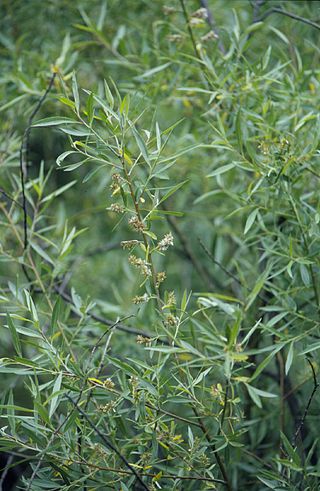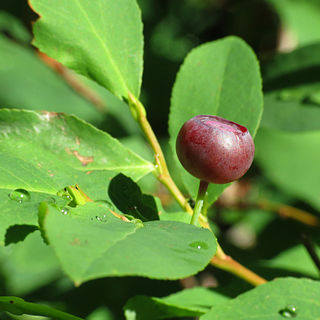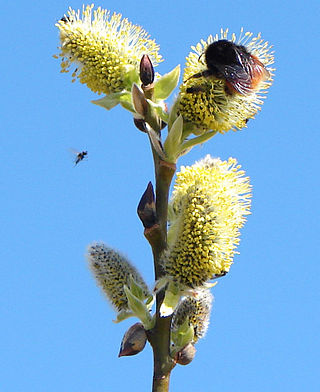
Willows, also called sallows and osiers, of the genus Salix, comprise around 350 species of typically deciduous trees and shrubs, found primarily on moist soils in cold and temperate regions.

Alnus rubra, the red alder, is a deciduous broadleaf tree native to western North America.

Salix caprea, known as goat willow, pussy willow or great sallow, is a common species of willow native to Europe and western and central Asia.

Salix × fragilis, with the common names crack willow and brittle willow, is a hybrid species of willow native to Europe and Western Asia. It is native to riparian habitats, usually found growing beside rivers and streams, and in marshes and water meadow channels. It is a hybrid between Salix euxina and Salix alba, and is very variable, with forms linking both parents.

Salix discolor, the American pussy willow or glaucous willow, is a species of willow native to North America, one of two species commonly called pussy willow.

Salix viminalis, the basket willow, common osier or osier, is a species of willow native to Europe, Western Asia, and the Himalayas.

Salix nigra, the black willow, is a species of willow native to eastern North America, from New Brunswick and southern Ontario west to Minnesota, and south to northern Florida and Texas.

Parkinsonia microphylla, the yellow paloverde, foothill paloverde or little-leaved palo verde; syn. Cercidium microphyllum), is a species of palo verde.

Carya glabra, the pignut hickory, is a common, but not abundant species of hickory in the oak-hickory forest association in the Eastern United States and Canada. Other common names are pignut, sweet pignut, coast pignut hickory, smoothbark hickory, swamp hickory, and broom hickory. The pear-shaped nut ripens in September and October, has a sweet maple like smell, and is an important part of the diet of many wild animals. The wood is used for a variety of products, including fuel for home heating. Its leaves turn yellow in the Fall.

Carya tomentosa, commonly known as mockernut hickory, mockernut, white hickory, whiteheart hickory, hognut, bullnut, is a species of tree in the walnut family Juglandaceae. The most abundant of the hickories, and common in the eastern half of the United States, it is long lived, sometimes reaching the age of 500 years. A straight-growing hickory, a high percentage of its wood is used for products where strength, hardness, and flexibility are needed. The wood makes excellent fuel wood, as well. The leaves turn yellow in Autumn.

Carya aquatica, the bitter pecan or water hickory, is a large tree, that can grow over 30 metres (98 ft) tall of the Juglandaceae or walnut family. In the American South it is a dominant plant species found on clay flats and backwater areas near streams and rivers. The species reproduces aggressively both by seed and sprouts from roots and from stumps of cut trees. Water hickory is a major component of wetland forests now in the south eastern US, because of the selective cutting of more desirable tree species for the lumber industry. It is considered important in cleansing drainage waters since the plants slow water flow during flooding, allowing sediments to fall out of the water column. This tree species is tolerant of wet soils but grows best on well draining soils near rivers and other water ways.

Salix bebbiana is a species of willow indigenous to Canada and the northern United States, from Alaska and Yukon south to California and Arizona and northeast to Newfoundland and New England. Common names include beaked willow, long-beaked willow, gray willow, and Bebb's willow. This species is also called red willow by Native Americans according to The Arctic Prairies Appendix E by Ernest Tompson Seton.

Salix geyeriana is a species of willow known by the common names Geyer's willow, Geyer willow and silver willow. The type specimen was collected by the botanist Karl Andreas Geyer, for whom it was named. Its conspicuous, yellow flowers begin to bloom as early as March, to as late as the end of June.

Vaccinium membranaceum is a species within the group of Vaccinium commonly referred to as huckleberry. This particular species is known by the common names thinleaf huckleberry, tall huckleberry, big huckleberry, mountain huckleberry, square-twig blueberry, and (ambiguously) as "black huckleberry".

Salix alaxensis is a species of flowering plant in the willow family known by the common names Alaska willow and feltleaf willow. It is native to northern North America, where it occurs throughout Alaska and northwestern Canada.

Salix arbusculoides is a species of flowering plant in the willow family known by the common name little tree willow. It is native to northern North America, where its distribution extends across Alaska and most of Canada.

Salix glauca is a species of flowering plant in the willow family known by the common names gray willow, grayleaf willow, white willow, and glaucous willow. It is native to North America, where it occurs throughout much of Alaska, northern and western Canada, and the contiguous United States south through the Rocky Mountains to northern New Mexico. It can also be found in Greenland, northwestern Europe, and Siberia.

Salix monticola is a species of flowering plant in the willow family known by the common names mountain willow, cherry willow, serviceberry willow, and park willow. It is native to the United States, where it occurs in the Rocky Mountains region from Wyoming to Arizona and New Mexico. It also occurs in Alaska and parts of Canada.

Salix richardsonii is a species of flowering plant in the Salicaceae, or willow family. It is known by the common names Richardson's willow and woolly willow. It is native to Russia and northern North America, where it occurs in Alaska and northern Canada. Some authorities consider it to be a subspecies, Salix lanata subsp. richardsonii(Hook.) A. K. Skvortsov rather than a species itself.






















